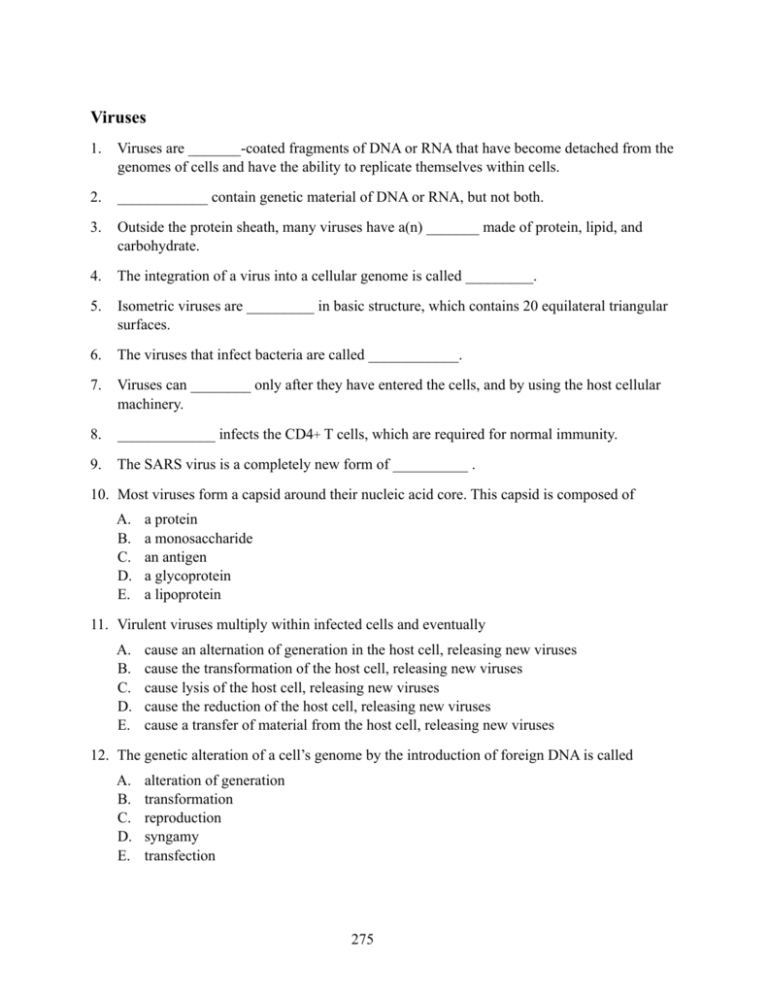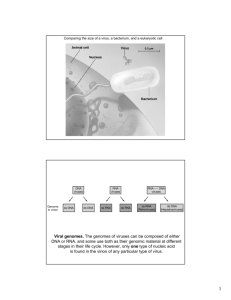Viruses - The Bio Edge
advertisement

Viruses 1. Viruses are _______-coated fragments of DNA or RNA that have become detached from the genomes of cells and have the ability to replicate themselves within cells. 2. ____________ contain genetic material of DNA or RNA, but not both. 3. Outside the protein sheath, many viruses have a(n) _______ made of protein, lipid, and carbohydrate. 4. The integration of a virus into a cellular genome is called _________. 5. Isometric viruses are _________ in basic structure, which contains 20 equilateral triangular surfaces. 6. The viruses that infect bacteria are called ____________. 7. Viruses can ________ only after they have entered the cells, and by using the host cellular machinery. 8. _____________ infects the CD4+ T cells, which are required for normal immunity. 9. The SARS virus is a completely new form of __________ . 10. Most viruses form a capsid around their nucleic acid core. This capsid is composed of A. B. C. D. E. a protein a monosaccharide an antigen a glycoprotein a lipoprotein 11. Virulent viruses multiply within infected cells and eventually A. B. C. D. E. cause an alternation of generation in the host cell, releasing new viruses cause the transformation of the host cell, releasing new viruses cause lysis of the host cell, releasing new viruses cause the reduction of the host cell, releasing new viruses cause a transfer of material from the host cell, releasing new viruses 12. The genetic alteration of a cell’s genome by the introduction of foreign DNA is called A. B. C. D. E. alteration of generation transformation reproduction syngamy transfection 275 13. Recently a class of infectious proteins with no associated nucleic acid, have been identified. They are referred to as A. B. C. D. E. bacteriophages latent viruses icosahedral viruses prions phage viruses 14. The HIV virus is considered a ______ virus, because after getting integrated into the host cell chromosomes, it does not begin replicating immediately. A. B. C. D. E. phage latent transforming non-reproducing transfection 15. Each HIV particle possesses a ___________ on its surface that precisely fits a cell-surface marker protein called CD4 on the surfaces of the immune system cells called macrophages and T cells. A. B. C. D. E. nucleic acid phospholipid polysaccharide glycolipid glycoprotein 16. Viruses are characterized by A. B. C. D. E. being found in every organism investigated so far being specific to the hosts they infect being able to reproduce independent of a host cell having either a helical or isometric structure being able to survive with other viruses as a group in the host cell 17. All of the following are diseases caused by viruses except A. B. C. D. E. strep throat AIDS polio small pox measles 276 18. Phages are viruses which can infect A. humans B. plants C. insects D. farm animals E. bacteria 19. A layer of lipoprotein and glycoprotein that covers the outer surface of some viruses is the A. B. C. D. E. capsid casing envelope membrane coat 20. Viruses that cause lysis of their hosts are called A. B. C. D. E. lethal potent temperate virulent latent 21. Viruses that become established as stable parts of the host cell genome are called A. B. C. D. E. lethal potent temperate virulent latent 22. Prions are A. B. C. D. E. strands of nucleic acids encased in a protein coat viral nucleic acids integrated into the host chromosomes viral-infected cells infectious proteins with no associated nucleic acid proteins coded by genes 23. Which of the following is a bacteriophage with an icosahedral head, a capsid that contains primarily three proteins, a connecting neck with a collar and long whiskers, a long tail and a complex base plate? A. B. C. D. E. influenza virus measles virus T2 HIV tuberculosis 277 24. The genetic alteration of a cell’s genome by the introduction of foreign DNA is called A. B. C. D. E. transfection transformation transcription translation transduction 25. Benign Vibrio cholerae becomes pathogenic by which of the following steps? A. A bacteriophage infects the V. cholerae by introducing a gene coding for the cholera toxin through the bacterial pili B. The incorporated phage gene is translated in the host C. The benign host is transformed into a disease causing agent by the toxin D. The host cell subsequently is lysed E. all of the above occur sequentially 26. The infection cycle of HIV includes all of the following steps except A. B. C. D. E. attachment entry replication killing the host cell immediately with no exceptions viral DNA integrates into the host chromosome 27. HIV studies revealed that it is closely related to A. B. C. D. E. chicken sarcoma virus ebola virus herpes virus a chimpanzee virus mad cow disease 28. The onset of AIDS is often accompanied by A. B. C. D. E. a steep drop in T cell numbers macrophage infection a positive HIV test lung infections and other opportunistic infections Kaposi’s sarcoma 29. Which of the following is not a form of HIV treatment? A. B. C. D. E. AZT protease inhibitors insulin chemokines and OAF T cell transfusion 278 30. An example of an ‘emerging virus’ (a virus in a new host) with a lethality rate in excess of 50% is A. B. C. D. E. Influenza virus Ebola virus hepatitis B variola virus yellow fever 31. Activation of a latent herpes virus is responsible for A. B. C. D. E. fever blisters AIDS syphilis Alzheimer’s disease dental caries 32. HIV infects cells by recognizing the cell-surface markers with its own A. B. C. D. E. DNA glycoproteins reverse transcriptase capsid protein enzymes 33. Mad-cow disease is caused by A. B. C. D. E. a bacterium a yeast an insect a parasite a prion 34. All of the following are true of viroids except A. B. C. D. E. they are tiny, naked molecules of RNA they are a few hundred nucleotides long viroid nucleotide sequences resemble intron sequences in ribosomal RNA genes they are causative agents of plant diseases they are tiny, naked molecules DNA and proteins 35. All viruses are constructed of A. B. C. D. DNA with a protein wrapping, called a capsid RNA with a protein wrapping, called a capsid either DNA or RNA with a protein wrapping, called a capsid either DNA or RNA, however many do not have the capsid 279 36. A scientist is investigating the lytic cycle of the T4 phage virus. This means she is examining the A. B. C. D. E. method used by the T4 phage to enter a bacterial cell method used by the T4 phage to replicate proteins method used by the T4 phage to replicate its DNA method used by the T4 phage to enter a cellular organelle of a bacterial cell method used by the T4 phage to begin protein synthesis on the bacterium’s ribosome 37. A scientist is studying the lysogenic cycle of the lambda 1 phase of Escherichia coli. This means that he is investigating A. the integration and stabilizing of the lambda 1 phase into a host cell’s genome B. the integration of the bacteria’s genome with the viral genome outside of the bacteria's cell wall C. the integration of the viral genome into the ribosomes present in the bacteria to direct protein synthesis for the capsid formation D. the integration and stabilizing of a virus into its capsid, which provides protection until conditions are better for reproduction 38. If a virus enters the lytic phase in a host’s cell, it will cause A. the host cell to reject the virus B. the host cell to shrink because of the loss of cytoplasm which has been used in the synthesis of viral DNA C. the host cell to burst because there will be so many viral particles present D. the host cell to replicate itself at a higher than normal frequency E. the host cell to initiate an attack on the virus 39. Scientists have demonstrated that the cholera bacteria, Vibrie cholerae, exist in at least two forms. It usually exists in a rather harmless form, however a phage conversion can occur which produces a disease-causing, virulent form. This conversion is caused by A. the phage entering the cholera bacterium genome and causing the bacterium's cell to lyse B. the phage introducing a gene into the bacterium's chromosome that codes for the cholera toxin which can cause death in humans C. the phage altering the cell wall of the cholera bacterium which produces a toxin that can cause death in humans D. the phage alters the host cell, which permits direct entry of the cholera bacterium into the host cell leading to death in humans 280 40. The specific white blood cells that HIV attaches to are the A. B. C. D. E. CD4-T cells gp120 -T cells CCR5-T cells CXCR4-T cells CD8-T cells 41. Diseases such as scrapie in sheep, “mad cow” disease in cattle, and Creutzfeldt-Jakob disease in humans are caused by A. B. C. D. E. viroids viruses retroviruses TSEs (transmissible spongiform encephalopathies) emerging viruses, for example Ebola 42. Viruses infect every organism that has been investigated for their presence. However, viruses can only replicate in A. very limited conditions, depending on their capsid type B. a very limited manner if they are a retrovirus C. a very limited manner depending on their envelope capability with the host's cell membrane or cell wall D. their lytic stage outside the host cell membrane E. a very limited number of the host’s cells 43. Viruses may cause cancer by A. B. C. D. E. corrupting the nuclear membrane which stimulates cell division inserting cancer causing genes into the cell’s genome triggering cell division through attachment to a cell surface receptor triggering the expression of cancer-causing genes present in the genome producing a chemical which halts cell division 44. Coronaviruses such as SARS fall into three groups based on their A. B. C. D. E. type of RNA surface proteins DNA structure isometric shape host range 281 Answer Key 282 No. on Test Correct Answer 1 protein 2 Viruses 3 envelope 4 lysogeny 5 icosahedral 6 bacteriophages 7 reproduce 8 HIV 9 coronavirus 10 A 11 C 12 B 13 D 14 B 15 E 16 C 17 A 18 E 19 C 20 D 21 C 22 D 23 C 24 B 25 E 26 D 27 D 28 A 29 C 30 B 31 A 32 B 33 E 34 E 35 C 36 A 37 A 38 C 39 B 40 A 41 D 42 E 43 D 44 B 283 284







